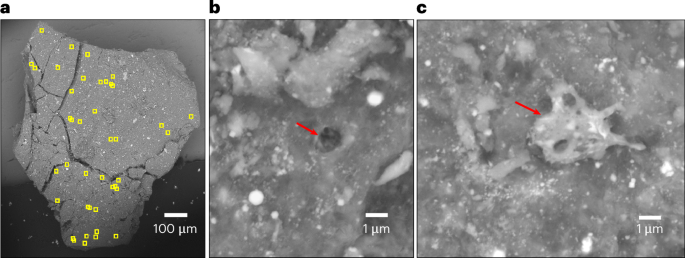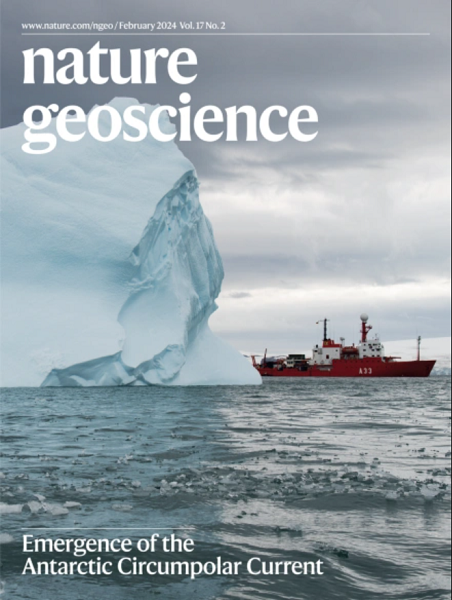本努小行星样本的空间风化效应
IF 16.1
1区 地球科学
Q1 GEOSCIENCES, MULTIDISCIPLINARY
引用次数: 0
摘要
OSIRIS-REx任务部署了接触垫采样器,从暴露在太空环境中的小行星Bennu的最上层表面收集风化层。由微流星体撞击和太阳辐射主导的空间风化过程,改变了暴露表面的矿物学和化学性质,在粘土上产生太阳风非晶化层,与高温熔体相关的金属须,以及由本地含氮气体与空间风化表面反应产生的氮化铁。在这里,我们使用宇宙稀有气体和放射性核素来表明,本努的上层风化层已经暴露在宇宙射线下2-7百万年了,这与遥感观测结果一致,表明小行星的表面是动态的,并且经常受到质量运动的影响。太阳高能粒子轨迹和微陨石坑密度限制了Hokioi陨石坑观测到的5万年空间风化光谱变化。这些光谱变化很大程度上是由撞击熔体沉积物在颗粒表面的积累所驱动的,尽管成分或晶粒尺寸的影响也可能发生。Bennu样本与从小行星Ryugu和Itokawa收集的样本的比较表明,微流星体撞击可能在小行星表面的空间风化中发挥了比最初认为的更积极和更快的作用,特别是对于碳质天体。本文章由计算机程序翻译,如有差异,请以英文原文为准。


Space weathering effects in Bennu asteroid samples
The OSIRIS-REx mission deployed contact pad samplers to collect regolith from the uppermost surface of the asteroid Bennu that was exposed to the space environment. Space weathering processes, dominated by micrometeoroid impacts and solar irradiation, modify the mineralogy and chemistry of exposed surfaces to produce solar wind-amorphized layers on clays, metallic whiskers associated with high temperature melts and Fe nitride created by the reaction of indigenous N-bearing gases with space-weathered surfaces. Here, we use cosmogenic noble gases and radionuclides to suggest that the upper metre of Bennu’s regolith has been exposed to cosmic rays for 2–7 million years, consistent with remote sensing observations indicating that the asteroid’s surface is dynamic and regularly modified by mass movement. Solar energetic particle track and microcrater densities constrain the space weathering spectral changes observed in Hokioi crater to <50,000 years. These spectral changes are driven largely by the accumulation of impact melt deposits on particle surfaces, although compositional or grain size effects may also occur. Comparison of Bennu samples with those collected from the asteroids Ryugu and Itokawa suggest that micrometeoroid impacts might play a more active and rapid role in the space weathering of asteroidal surfaces than was initially suggested, particularly for carbonaceous bodies. Material from the Hokioi crater on asteroid Bennu experienced space weathering and suggests microcratering plays a more active role on carbonaceous bodies than initially thought, according to a study of OSIRIS-REx asteroid return samples.
求助全文
通过发布文献求助,成功后即可免费获取论文全文。
去求助
来源期刊

Nature Geoscience
地学-地球科学综合
CiteScore
26.70
自引率
1.60%
发文量
187
审稿时长
3.3 months
期刊介绍:
Nature Geoscience is a monthly interdisciplinary journal that gathers top-tier research spanning Earth Sciences and related fields.
The journal covers all geoscience disciplines, including fieldwork, modeling, and theoretical studies.
Topics include atmospheric science, biogeochemistry, climate science, geobiology, geochemistry, geoinformatics, remote sensing, geology, geomagnetism, paleomagnetism, geomorphology, geophysics, glaciology, hydrology, limnology, mineralogy, oceanography, paleontology, paleoclimatology, paleoceanography, petrology, planetary science, seismology, space physics, tectonics, and volcanology.
Nature Geoscience upholds its commitment to publishing significant, high-quality Earth Sciences research through fair, rapid, and rigorous peer review, overseen by a team of full-time professional editors.
 求助内容:
求助内容: 应助结果提醒方式:
应助结果提醒方式:


